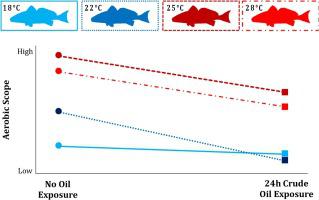Aquatic Toxicology ( IF 4.1 ) Pub Date : 2021-02-11 , DOI: 10.1016/j.aquatox.2021.105773 Kerri Lynn Ackerly , Andrew J. Esbaugh

|
The 2010 Deepwater Horizon (DWH) crude oil spill, among the largest environmental disasters in U.S. history, affected numerous economically important fishes. Exposure to crude oil can lead to reduced cardiac function, limiting oxygen transport, ATP production, and aerobic performance. However, crude oil exposure is not the only stressor that affects aerobic performance, and increasing environmental temperatures are known to significantly increase metabolic demands in fishes. As the DWH spill was active during warm summer months in the Gulf of Mexico, it is important to understand the combined effects of oil and temperature on a suite of metabolic parameters. Therefore, we investigated the effects of 24h crude oil exposure on the aerobic metabolism and hypoxia tolerance of red drum (Sciaenops ocellatus) following 3 week chronic exposure to four ecologically relevant temperatures (18 °C, 22 °C, 25 °C, 28 °C). Our results show that individuals acclimated to higher temperatures had significantly higher standard metabolic rate than individuals at lower temperatures, which resulted in significantly decreased critical oxygen threshold and reduced recovery from exercise. As predicted, crude oil exposure resulted in lower maximum metabolic rates (MMR) across the temperature range, and a significantly reduced ability to recover from exercise. The lowest temperature acclimation showed the smallest effect of oil on MMR, while the highest temperature showed the smallest effect on exercise recovery. Reduced respiratory performance and hypoxia tolerance are likely to have meaningful impacts on the fitness of red drum, especially with climate-induced temperature increases and continued oil exploration in the Gulf of Mexico.
中文翻译:

温度对红鼓油(Sciaenops ocellatus)油诱导的呼吸系统损伤的影响
2010年深水地平线(DWH)原油泄漏是美国历史上最大的环境灾难之一,影响了许多具有重要经济意义的鱼类。暴露于原油中会导致心脏功能下降,限制氧气的运输,ATP的产生和有氧运动。但是,暴露于原油并不是影响有氧性能的唯一压力源,众所周知,环境温度的升高会显着增加鱼类的代谢需求。由于DWH溢漏在墨西哥湾的炎热夏季活跃,因此了解油和温度对一组代谢参数的综合影响非常重要。因此,我们调查了24h原油暴露对红鼓(Sciaenops ocellatus)有氧代谢和耐缺氧性的影响)长期暴露在四个与生态相关的温度下(18°C,22°C,25°C,28°C),历时3周。我们的结果表明,适应较高温度的个体比处于较低温度的个体具有显着更高的标准代谢率,这导致临界氧阈值显着降低和运动恢复。如预测的那样,暴露在原油中会导致在整个温度范围内降低最大代谢率(MMR),并显着降低运动后恢复能力。最低温度适应对MMR的影响最小,而最高温度对运动恢复的影响最小。呼吸功能下降和耐缺氧性可能对红鼓的适应性产生有意义的影响,











































 京公网安备 11010802027423号
京公网安备 11010802027423号